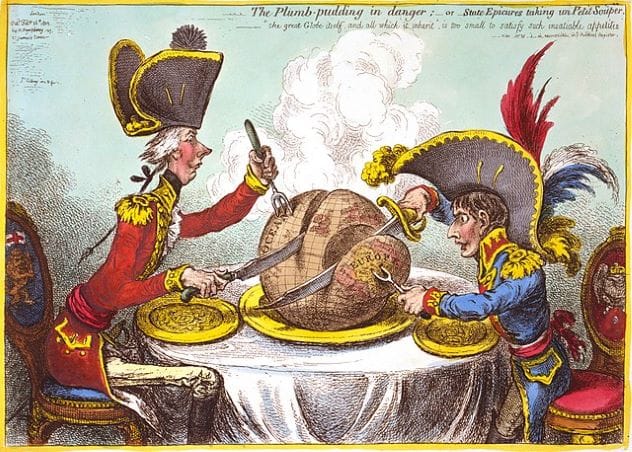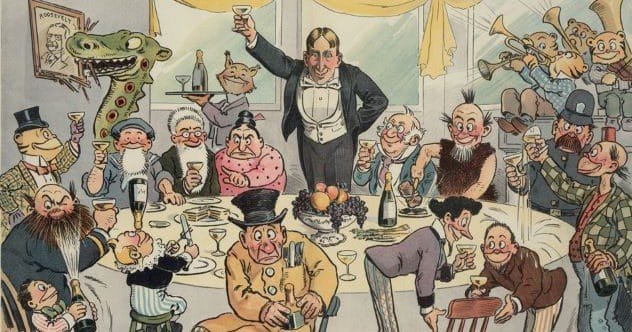Cartoons have always been a staple of subtle sarcasm, from family-friendly comics to those that pack a political punch. Political cartoons capture our attention, offering a silent, artistic protest that often says what many are afraid to voice. Here are ten cartoons with powerful messages that have resonated around the world.
“The Plumb-Pudding in Danger” by James Gillray

James Gillray’s “The Plumb-Pudding in Danger” is a commentary on early 19th-century European geopolitics. Created in 1805, amidst the Napoleonic Wars, it depicts British Prime Minister William Pitt the Younger and French Emperor Napoleon Bonaparte carving into a globe-shaped plum pudding, symbolizing the world.
Pitt, representing Great Britain, and Napoleon, representing France, jovially carve into the pudding, concealing strategic calculations and tensions. The cartoon encapsulates the Anglo-French relationship, with the shared table symbolizing collaboration and potential dissolution. Gillray’s detailing conveys the subtleties of international diplomacy.
“Why So Angry” by Rob Rogers
Rob Rogers captures the struggles of the Black community in “Why So Angry.” Rogers sheds light on the persistent mistreatment of Black people and the frustration leading to protests.
Rogers depicts the cycle of injustice, highlighting how little has changed despite societal progress. The cartoon portrays the palpable anger within the Black community, using shades of blue to symbolize sadness and frustration. A colored image shows a white man in a red hat questioning the anger and protests, embodying the unwillingness to recognize deep-rooted injustices.
“Join, or Die” by Benjamin Franklin
Benjamin Franklin’s 1754 cartoon, “Join, or Die,” is a symbol of unity. Featuring a segmented snake representing British American colonies, it urges colonies to unite against the French during the French and Indian War.
The disjointed snake symbolizes vulnerability, while the slogan underscores the need for collaboration. It later became a rallying cry for the American Revolution and the ratification of the U.S. Constitution, emphasizing the importance of cohesive efforts.
“We Can Do It!” by J. Howard Miller
“We Can Do It!” by J. Howard Miller represents empowerment during World War II. Featuring Rosie the Riveter, it symbolizes women’s resilience in times of national crisis.
Created in 1943 to boost morale and encourage women to join the war effort, Rosie exudes confidence with her rolled-up sleeves and flexed arm. It challenges gender roles and emphasizes women’s vital role, still serving as a symbol for equal pay and inspiring women across generations.
“The Choice” by Ann Telnaes
Ann Telnaes captured the essence of the 2000 presidential election in “The Choice.” This satire humorously portrays Al Gore and George W. Bush as competing cereal choices.
Gore is cast as a box of bran cereal, described as “artificial,” while Bush is frosted flakes, labeled “sugary” and “nutz.” The inclusion of additional candidates in a “variety pack cereal” underscores the limited choices available to voters.
“My Body My Choice” by Harry Burton
Harry Burton’s “My Body My Choice” addresses autonomy and power dynamics. Inspired by Grant Wood’s American Gothic, Burton reinterprets the scene to address bodily autonomy.
An upside-down American flag symbolizes distress. The wife says, “My body,” while the husband, dressed as a Supreme Court judge, retorts, “My choice.” Burton highlights the systemic structures holding authority over personal freedoms.
“Fistbump: The Politics of Fear” by Barry Blitt
“Fistbump: The Politics of Fear” by Barry Blitt comments on the 2008 U.S. Presidential Election. It depicts Barack Obama and his wife Michelle exchanging a fist bump in the Oval Office, set against fear-mongering tactics.
The cartoon shows tension between Obama’s message of hope and fear-based strategies. The White House setting suggests a clandestine atmosphere, alluding to the divisive political climate. Details like the Bin Laden portrait and burning U.S. flag sparked controversy.
“Migrant Child Facility” by Lalo Alcaraz
Lalo Alcaraz’s “Migrant Child Facility” juxtaposes the treatment of migrant children under Donald Trump and Joe Biden. The cartoon presents a side-by-side view, highlighting the political manipulation of language.
Under Trump, a child is confined in a cage labeled “Kids in cages.” Under Biden, the same child is in the same cage, but the label reads “Migrant child facility.” The critique is on repackaging issues under palatable names without addressing core problems.
“Trump Sycophants” by Michael Ramirez
Michael Ramirez’s “Trump Sycophants” captures loyalty, leadership, and ethics. Uncle Sam mans a coat check at a GOP debate, with a sign reading “Hat, coat, and spine check.”
A clown hat symbolizes prioritizing loyalty over sound decision-making. Human spines hanging next to coats convey candidates leaving their moral backbone for loyalty. The cartoon highlights the moral dilemma of prioritizing loyalty over principles.
“The Bosses of the Senate” by Joseph Keppler
Joseph Keppler’s “The Bosses of the Senate” is a commentary on corporate influence. Created in 1889, during political corruption, the cartoon depicts an octopus with its tentacles wrapped around the Senate chamber.
The octopus symbolizes corporate power suffocating democratic institutions. Each tentacle represents a specific industry influencing lawmakers. The cartoon sparked conversations about campaign finance reform and curbing the undue influence of moneyed interests.
These political cartoons, through their art and commentary, have shaped global discourse, sparking conversations and challenging perspectives. They remain powerful reminders of the issues that define our societies.
Which cartoon resonated with you the most? Leave your comment below!










